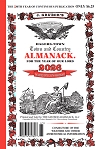John Gruber and His Famous Almanack
ohn Gruber’s name still appears prominently on the cover of his best-known publication, The Hagerstown Town and Country Almanack that first made its appearance in the Hagerstown, Maryland area in 1797. It is the second oldest almanac in the United States and in fact, the oldest almanac that is still published today by heirs of its founder. The first almanac of record was established by Robert Bailey Thomas in 1792 and was first printed in Boston as The Farmer's Almanac. Today, The Old Farmer’s Almanac ('Old' was added to the the name in 1847) is currently published by Rob Sagendorph in Dublin, New Hampshire.
Gruber’s Hagerstown Town and Country Almanack has been a mainstay tradition in the Mid-Atlantic Region for well over two centuries, providing farmers with seasonal weather forecasts as well as critically important astronomical information considered to be vital to agricultural success in the region.
Gruber holds three distinct places in history: not only is his almanac the second oldest almanac in the country (actually, it is the ONLY almanac that is still published and sold by descendants of its founder), the company he founded in 1797 is the 46th oldest company in the U.S, and his songster, 'National Songster of 1814', published in Hagerstown, Maryland, was the first songster to publish the poem, 'The Defence of Fort M' Henry' as a song that would eventually become our National Anthem! For the full story, click here.
THE EARLY YEARS
John (or Johann) Gruber was born on October 31, 1768 in Strasburg, Lancaster County, Pennsylvania, the eldest son of Dr. John Eberhard Gruber (1736-1814) and grandson of Johann Adam Gruber (1693-1763), born in Kempten, Bavaria and who had emigrated to America in 1726 (or 1724 according to some sources) and settled in the Germantown area of Philadelphia.
Against his father’s wishes, the young Gruber choose a mechanical trade rather than the medical profession and at age 15 was apprenticed to Charles Grist of Philadelphia, Pennsylvania to learn the printing trade. During his apprenticeship in Philadelphia, he had the rare privilege of following in the funeral procession of Benjamin Franklin.
Gruber's health was feeble at the termination of his apprenticeship and on July 2, 1791, under the advice of his physician father, he embarked on an extended sea voyage bound for Hispaniola (now San Domingo). Sailing on the sloop, "Charming Sally," commandeered by Captain Robert Lillibridge, he reached port safely, but the young Gruber arrived amidst the violent uprising of 1793 that would eventually lead to the West India island’s independence from French rule. He soon secured a position as compositor for a French paper. Over time, his health vastly improved, but as the rebellion reached its height, Gruber began to fear for his life. Disguised as a sailor, he quickly fled the island "amid scenes of the most terrible bloodshed and carnage, ever recorded in history."
Gruber’s voyage home was just as eventful. A violent storm arose and when the ship neared Cape May, New Jersey, its was continuously blown back to sea. For several weeks, the passengers and crew were in peril of their lives from both the storm and threatening starvation. The ship finally made the port of Philadelphia where Gruber soon found printing work for a short period of time.
In 1793, he moved to Reading, Berks County, Pennsylvania, and on June 26th, entered into a partnership with Gotlob Jungman. Under the firm name of Jungman and Gruber, he printed the publication, Neue Unpartheyischa Readinger Zeitung und Anzeigs-Hachrichten (literal translation: ‘New Candid Reading Newspaper and Advertising Messages’). This is believed to be the very first newspaper published in Reading. It was during his stay in Reading that he married Catherine Alles (1777-1859), daughter of Captain Henry Alles, a prominent officer in the First United States Continental Army during the American Revolution.
For more on JOHN GRUBER AND HIS FAMOUS ALMANACK, click here


















